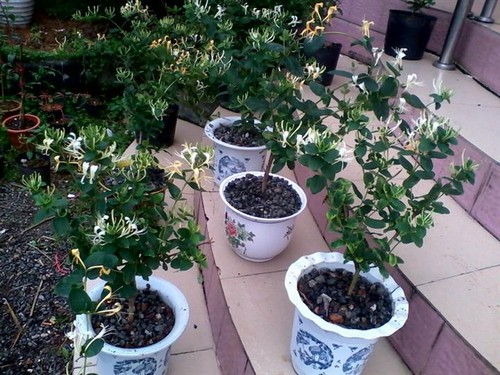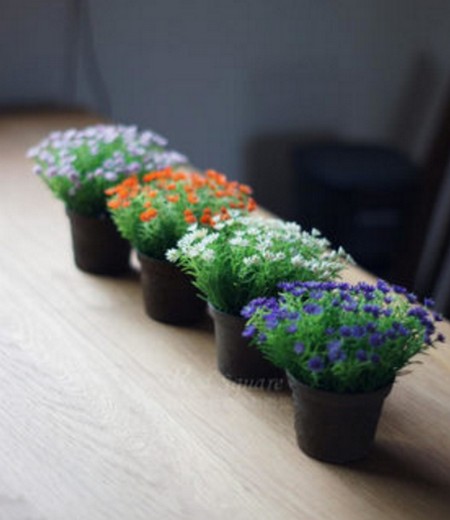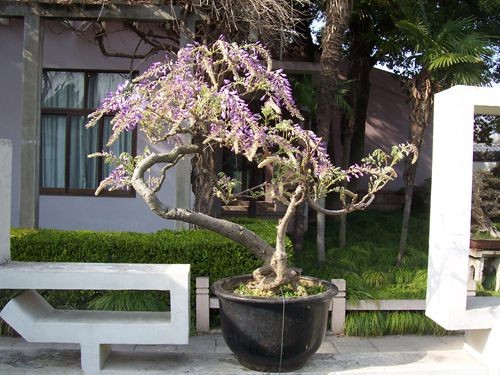How to grow honeysuckle
Honeysuckle is not only a common medicine, but also a kind of ornamental plant, honeysuckle bonsai is also quite good-looking, so which of the honeysuckle planting techniques we need to pay special attention to? First of all, the selection of land is very important, the requirements of honeysuckle planting on the environment are still very high, and then the prevention and control of diseases and insect pests is also a difficulty that we have to overcome.

You must think it is incredible that a small honeysuckle can also be made into a bonsai. Honeysuckle vines around, winter leaves slightly red, winter does not wither; yellow and white, blooming constantly, first white and then yellow, color and fragrance, flowers and leaves are both beautiful, spring and summer. So what is the planting technology of honeysuckle?
Honeysuckle planting techniques:
1. Timely transplanting: when the seedling age is one year, the seedlings can be transplanted in the season from the Spring Equinox to Grain Rain. The density is determined by the soil quality, and the distance of each hole is generally 2 × 2.5-3 meters. Before transplanting, you should dig a hole with a width of 60-70 cm and a depth of 40-50 cm, and apply enough farm manure, 30-50 kg per hole. 1-2 plants per hole is suitable for fertile soil, 3 plants can be planted in one hole in lean soil, and the number of holes per mu is controlled at about 120 to 140.
2. Field management: watering in time after transplanting to ensure the survival rate. After one month, light feces and urine water or nitrogen fertilizer water of 300% were applied every 15 days or so. When the new buds grow to more than 2 nodes, pick the heart in time, promote the lateral branches to grow into clumps early, and set up the frame at the right time depending on the length of the vine, so as to facilitate the winding growth of the new vine. After picking flowers, it is necessary to timely cut off diseased, withered and weak branches, weed and loosen the soil, and apply fertilizer to ensure high yield in the coming year.
3. Pest control and disease treatment: mainly budding and powdery mildew. The basic drugs for prevention and treatment can be sprayed with colloidal sulfur mixture, that is, colloidal sulfur 100g, trichlorfon 10g, dimethoate 15g, plus 30kg water, generally every 15 days.
4. Flower picking and processing: timely flower picking and processing from May to June. The processing method can be dried in the shade, dried or smoked with sulfur, then dried in the sun, or dried in a light fire or electric oven, but the appropriate temperature should be mastered to make the color and dryness just right to prevent blackening. It should be sealed and stored after drying to prevent damp discoloration and moth.
Planting skills of Honeysuckle:
First of all, a better piece of land should be selected to turn the soil and fertilize it. Of course, if the conditions do not permit, as shown in the picture, use barren slopes, edges, ditches, and sporadic plots at the front and back of the house.
The second is transplanting. Generally, when transplanting, you will choose the dormancy period before early spring germination or autumn and winter. At this time, on the whole plot, dig holes according to row spacing of 100 cm and plant spacing of 60 cm, and then add 5 kg of soil and miscellaneous fertilizer to these holes. After mixing well with the subsoil, you can transplant the seedlings, and then begin to fill the fine soil to compact, firmly, and pour through the fixed root water.
Then weeding and topdressing. After transplanting, honeysuckle is generally planted and weeded three or four times a year, the first time when sprouting in spring, the second time in June, the third time from July to August, and the fourth time in late autumn and early winter. After germination in early spring and after picking flower buds every year, topdressing should be carried out once. Mature human and animal dung water or ammonium sulfate or urea can be used in spring and summer. In winter, mature barnyard manure or compost 5 to 10 kilograms, ammonium sulfate 100 grams, calcium superphosphate 200 grams.
Finally, plastic surgery and trimming. If you want a very good tree-shaped honeysuckle, pruning and shaping is an essential link, which can not only promote more new branches and form more buds, play a role in increasing production, but also broaden the branches, make them evenly distributed, ventilated and transparent, which is beneficial to the quality of honeysuckle.
The main diseases and insect pests harmful to the growth of honeysuckle are Chinese honeysuckle aphid and powdery mildew.
1. Chinese honeysuckle flower aphid
Aphids mainly occur in spring and summer, control aphids, you can use Amoy rice water fermentation, filtration plus the same amount of water spray, the effect is very good, there is no pollution.
2. Powdery mildew
Powdery mildew mainly occurs in the wet season of rainy and high temperature in summer and autumn. when it occurs, the diseased leaves and diseased branches are subtracted, the covered branches and leaves are thinned, and the plant can be controlled by keeping the plant ventilated and transparent. In severe cases, 50% wettable carbendazim powder can be sprayed with 500 times liquid. Cut diseased branches and leaves should be taken out of the garden to be burned or buried deeply, and should not be abandoned in the garden to prevent re-infection.
Time: 2019-05-25 Click:
- Prev

Do not forget how to grow.
Forget-me-not is a small pale blue flower with five petals and no fragrance. Although ordinary, but couples are willing to tie them into a bunch of gifts to their lovers, in order to express deep love. Forget-me-not flowers are small and delicate, with a variety of colors, although common
- Next

Key points of planting techniques of wisteria bonsai
Wisteria has strong taproot, so it is advisable to dig lateral roots as much as possible and bring land when transplanting. More than planting in early spring, it is necessary to set up a frame before planting, and tie the coarse branches to the rack to make it climb along the shelf. Because of the long life of wisteria, thick branches and luxuriant leaves, the scaffolding material must be solid and durable. When young trees are first planted, the branches cannot form flower buds.
Related
- Fuxing push coffee new agricultural production and marketing class: lack of small-scale processing plants
- Jujube rice field leisure farm deep ploughing Yilan for five years to create a space for organic food and play
- Nongyu Farm-A trial of organic papaya for brave women with advanced technology
- Four points for attention in the prevention and control of diseases and insect pests of edible fungi
- How to add nutrient solution to Edible Fungi
- Is there any good way to control edible fungus mites?
- Open Inoculation Technology of Edible Fungi
- Is there any clever way to use fertilizer for edible fungus in winter?
- What agents are used to kill the pathogens of edible fungi in the mushroom shed?
- Rapid drying of Edible Fungi

